新概念英语第一册 Lesson 5完整版本
新概念英语第一册Lesson5教案
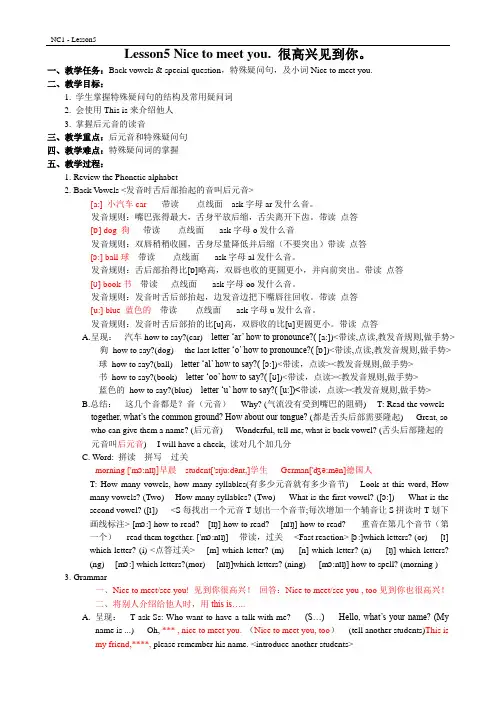
Lesson5 Nice to meet you. 很高兴见到你。
一、教学任务:Back vowels & special question,特殊疑问句,及小词Nice to meet you.二、教学目标:1. 学生掌握特殊疑问句的结构及常用疑问词2. 会使用This is来介绍他人3. 掌握后元音的读音三、教学重点:后元音和特殊疑问句四、教学难点:特殊疑问词的掌握五、教学过程:1. Review the Phonetic alphabet2. Back V owels <发音时舌后部抬起的音叫后元音>[a:]小汽车car --- 带读--- 点线面---ask字母ar发什么音。
发音规则:嘴巴张得最大,舌身平放后缩,舌尖离开下齿。
带读点答[ɒ] dog 狗--- 带读--- 点线面--- ask字母o发什么音发音规则:双唇稍稍收圆,舌身尽量降低并后缩(不要突出)带读点答[ɔ:]ball球---带读--- 点线面--- ask字母al发什么音。
发音规则:舌后部抬得比[ɒ]略高,双唇也收的更圆更小,并向前突出。
带读点答[ʊ]book书---带读---点线面--- ask字母oo发什么音。
发音规则:发音时舌后部抬起,边发音边把下嘴唇往回收。
带读点答[u:]blue 蓝色的---带读--- 点线面--- ask字母u发什么音。
发音规则:发音时舌后部抬的比[u]高,双唇收的比[u]更圆更小。
带读点答A.呈现:---汽车how to say?(car)---letter ‘ar’ how to pronounce?( [a:])<带读,点读,教发音规则,做手势>---狗how to say?(dog)--- the last le tter ‘o’ how to pronounce?( [ɒ])<带读,点读,教发音规则,做手势>---球how to say?(ball)---letter ‘al’ how to say?( [ɔ:])<带读,点读><教发音规则,做手势>---书how to say?(book)---letter ‘oo’ how to say?( [ʊ])<带读,点读><教发音规则,做手势>---蓝色的how to say?(blue)---letter ‘u’ how to say?( [u:])<带读,点读><教发音规则,做手势>B.总结:---这几个音都是?音(元音)--- Why? (气流没有受到嘴巴的阻碍) ---T: Read the vowelstogether, what’s the common ground? How about our tongue? (都是舌头后部需要隆起) --- Great, sowho can give them a name? (后元音) --- Wonderful, tell me, what is back vowel? (舌头后部隆起的元音叫后元音)--- I will have a check, 读对几个加几分C. Word: 拼读---拼写---过关morning ['mɔ:nɪŋ]早晨student['stju:dənt,]学生German['dʒə:mən]德国人T: How many vowels, how many syllables(有多少元音就有多少音节) ---Look at this word, Howmany vowels? (Two) ---How many syllables? (Two) --- What is the first vowel? ([ɔ:]) --- What is thesecond vowel? ([ɪ]) --- <S每找出一个元音T划出一个音节;每次增加一个辅音让S拼读时T划下画线标注> [mɔ:] how to read?---[ɪŋ] how to read? ---[nɪŋ] how to read? --- 重音在第几个音节(第一个)--- read them together. ['mɔ:nɪŋ] ---带读,过关--- <Fast reaction> [ɔ:]which letters? (or) --- [ɪ]which letter? (i) <点答过关> ---[m] which letter? (m) --- [n] which letter? (n) --- [ŋ] which letters?(ng) ---[mɔ:] which letters?(mor) ---[nɪŋ]which letters? (ning) --- [mɔ:nɪŋ] how to spell? (morning )3. Grammar一、Nice to meet/see you! 见到你很高兴!回答:Nice to meet/see you , too见到你也很高兴!二、将别人介绍给他人时,用this is…..A. 呈现:---T ask Ss: Who want to have a talk with me? --- (S…) --- Hello, what’s your name? (Myname is ...) --- Oh, *** , nice to meet you. (Nice to meet you, too)--- (tell another students)This ismy friend,****, please remember his name. <introduce another students>B. 讲解:--- Ok, please tell me: what did I do just now? (交朋友,然后把朋友介绍给别人) --- good,那么我们交到朋友了,要对他说?(Nice to meet you)<板书,带读,背诵> --- what’s the meaning?( 很高兴见到你。
新概念英语第一册Lesson5-6Nicetomeetyou小学英语-教学设计教案-初中英语全国通用
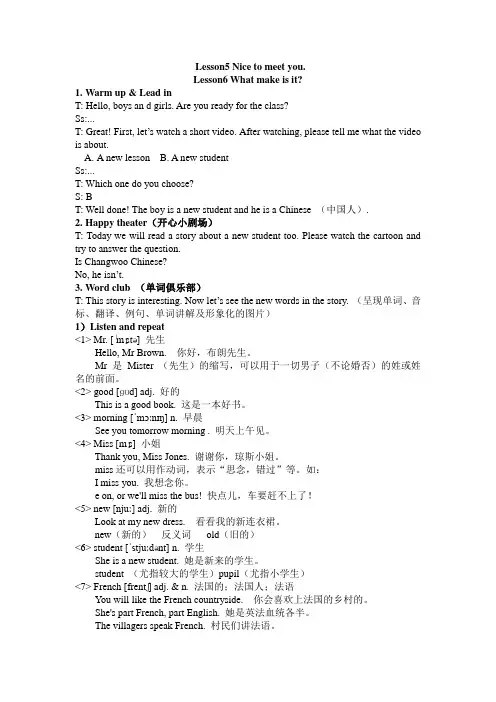
Lesson5 Nice to meet you.Lesson6 What make is it?1.Warm up & Lead inT: Hello, boys an d girls. Are you ready for the class?Ss:...T: Great! First, let’s watch a short video. After watching, please tell me what the video is about.A.A new lessonB. A new studentSs:...T: Which one do you choose?S: BT: Well done! The boy is a new student and he is a Chinese (中国人).2.Happy theater(开心小剧场)T: Today we will read a story about a new student too. Please watch the cartoon and try to answer the question.Is Changwoo Chinese?No, he isn’t.3.Word club (单词俱乐部)T: This story is interesting. Now let’s see the new words in the story. (呈现单词、音标、翻译、例句、单词讲解及形象化的图片)1)Listen and repeat<1> Mr. [ˈmɪstə] 先生Hello, Mr Brown. 你好,布朗先生。
Mr 是Mister (先生)的缩写,可以用于一切男子(不论婚否)的姓或姓名的前面。
<2> good [ɡʊd] adj. 好的This is a good book. 这是一本好书。
新概念英语Lesson 5
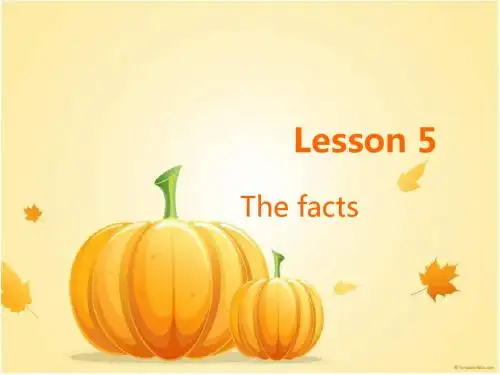
• circle 圆圈;around 坏绕
• weight 体重;width 宽度;length 长度
• meanwhile adv. 同时
• at the same time 同时
• refuse v. 拒绝
• refuse to do sth=be unwilling to do sth 不愿意做某事
• • • • • • •
well-known 为复合形容词,修饰magzine n. + adj. life-long 终生的 adj.+adj. red-hot 炙手可热的 n.+ v.-ing peace-loving 热爱和平的 n.+v.-ed man-made 人造的 adj.+ v.-ing good-looking 漂亮的 adj. + v.-ed kind-hearted 仁慈的
• the Summer Palace 颐和园; the Palace Museum 故 宫; • the White House 白宫
• publish v. 出版,发表
• fax n. 传真
• letter 信件;delivery 快递; typewriter 打字机
• impatient adj. 不耐烦的
• anxious焦虑的;irritated易怒的; • hot-tempered暴 解雇
• dismiss 开除;expel 开除
• originally adv. 起初,原先
• in the beginning 开始
• instruct v. 吩咐,指示
• Not only had the poor man been arrested, but he had been sent to prison as well. • not only 放在句首引起部分倒装 • 倒装有时是句子结构需要,有时是表示强调修辞手法需要。 • only所修饰的副词,介词短语或状语从句放在句首时,要用: • only+ 状语+ be /助动词/情态动词+主语及其他 • Only when he told me the news did I know what had happened. • Only in this way can you make progress in your English. • Only through education can we rise in the world.
新概念英语第一册Lesson5-6课
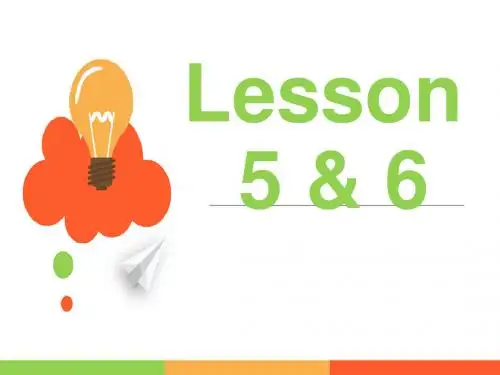
在英语口语中,如果希望别人给自己“出 示” 什么东西时,通常是“要什么直接说什 么”。
eg: 请出示你的票。 Your ticket, please. 请让我看看你的护照。 Your passport, please. 请告诉我你的名字。 Your name, please.
Swedish
Stockholm is ___________
Swedciasphital.
Sweden 瑞典 Swedish 瑞典人
瑞典的
Remember ?
国家:
Fill in the blanks:
1.He is from Japan. He's _J_a_p_a__n_e_s_e_.
England 英国 English 英国人
英国的
It's from America.
American
It's
an_A__m__e_r_i_c_a_n__president.
America 美国 American 美国人
美国的
It's from Switzerland.
Swit Swiss
Lesson 5&6
Where is it from ?
It's from China.
Chinese
It's a _C_h__in__e_s_e_cartoon.
China Chinese
中国
中国人 中国的
It's from Japan.
Japanese
It's
a_J_a__p_a_n__e_s_e__mountain.
Thank you, sir. Number five.
新概念英语第一册第5_6课_ppt
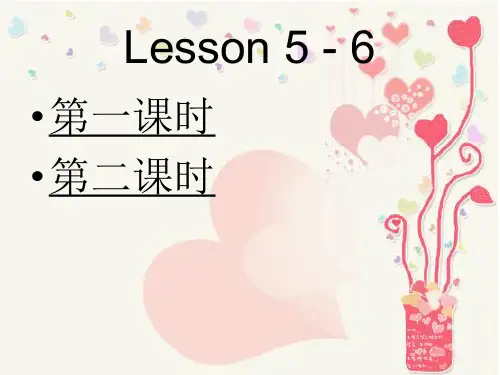
a 一个,一辆 ,一只… 例如 a car 表示一个还可以用 an,例如 an apple
a 与 an 在英语被称为不定冠词,二者在意义上没 有区别,但是,在发音以辅音音素开头的词前用a; 在发音以元音音素开头的词前用an。
主格代词顺口溜: 我是I ,你是You ; 男他He ,女她She ,动物的它是It; 我们We ,你们You ,他们They. Who are you ?
And this is Chang-woo. He’s Korean. “Nice to meet you .”
he’s = he is he’s 是 he is 的缩写形式 she’s = she is she’s 是 she is 的缩写形式 it’s = it is it’s 是 it is 的缩写形式
And this is Luming. He’s Chinese .
“Nice to meet you .”
And this is Xiaohui . She’s Chinese , too .
“Nice to meet you .”
总结
• 早上打招呼 答语是
• 介绍别人
Nice to meet you.nice 美好的 ;meet 遇见 很高兴见到你。
练习2
• 看书上12页练习B This is Miss Sophie Dupont. French/(Swedish) Is she a French student or a Swedish student? She isn't a Swedish student. She's a French student.
英语国家中人的姓名通常由3部分组 成,即:名+中间名+姓。 在一般情况下,不用中间名。在熟悉 的人中间,以名相称,而在正式的场 合中常用 Mr.(先生),Mrs.(太 太),Miss(小姐)或Ms.(女士) 这些称呼再加上姓。
新概念英语第一册 Lesson5~6带答案)(共40张PPT)

记忆面包条 --好句推荐 This is … 用来介绍某人,这是... Nice to meet you. 见到你很高兴。
Grammar
1. 不定冠词的使用
冠词: 不定冠词(a, an) 定冠词(the)
三个冠 词 the an
a
分类
定冠词 不定冠 词
不定冠 词
用法
详见L25-26 重点语法2
2.雨 水 管 、 污 水管 发生堵 塞、冒 溢; 3.门 、 窗 安 装 不密 闭,出现 翘裂; 4.墙 面 、 顶 棚 抹灰 层脱落 ; 5.照 明 线 路 发 生故 障;
屋 面 防 水 保 修3年,其 他部 位、部 件的保 修期限 ,由房地 产开发 企业与 用户自 行约定 。
因 住户使 用、装 修不当 或
Vocabulary
(6) 国家和国籍
France
I am French.
Vocabulary
Germany
I am German.
Vocabulary
Japan I am Japanese.
Vocabulary
Korea
I am Korean.
I am Korean , too
Vocabulary
Vocabulary
课文原句重现:She is French. 表达:表示国籍的名词前通常没有冠词。表示国 籍的词,首字母要_大_写______。 判断对错:
I am Chinese. (__√__) I am a Chinese. (_×___)
Vocabulary
(7) nice adj. 美好的 e.g. _T_h_i_s_d_r_e_s_s_i_s _v_e_ry__n_ic_e_.__________.
新概念英语第一册Lesson 5 Nice to meet you
Lesson 5 Nice to meet you很高兴见到你。
Listen to the tape then answer this question. Is Chang-woo Chinese? 听录音,然后回答问题。
昌宇是中国人吗?MR. BLAKE: Good morning.STUDENTS: Good morning, Mr. Blake.MR. BLAKE: This is Miss Sophie Dupont.Sophie is a new student.She is French.MR. BLAKE: Sophie, this is Hans.He is German.HANS: Nice to meet you.MR. BLAKE: And this is Naoko.She's Japanese.NAOKO: Nice to meet you.MR. BLAKE: And this is Chang-woo.He's Korean.CHANG-WOO: Nice to meet you.MR. BLAKE: And this is Luming.He is Chinese.LUMNG: Nice to meet you.MR. BLAKE: And this is Xiaohui.She's Chinese, too.XIAOHUI: Nice to meet you.New Word and expressions 生词与短语Mr.先生goodadj. 好Miss小姐newadj. 新的studentn. 学生Frenchadj. & n. 法国人Germanadj. & n. 德国人niceadj. 美好的meetv. 遇见Japaneseadj. & n. 日本人Koreanadj. & n. 韩国人Chineseadj. & n. 中国人tooadv. 也本文参考译文布莱克先生:早上好。
新概念英语第一册 Lesson 5完整版本
• 掌握两课中的单词及专业词汇。 • 熟练运用课堂所讲解的日常用语。
What is the country?
• China • Japan • Korea • France • England
Chinese Japanese Korean French English
课文讲解
• Morning用法拓展 • 1,in the morning
• 2,在星期天早上: on Sunday morning • 3,在一个冬天的早晨: on a winter morning
• Eg:I go to school____8 o’clock in the morning. A.at B.in C.on D.for
he
France 法国
[fra:ns]
French 法国人
[frentʃ]
he
Germany 德国
[’dʒə:məni]
巴拉克
German 德国人
[’dʒə:mən]
某国
(中) China [‘t∫aɪnə]
(日) Japan [dʒə‘pæ n]
(韩) Korea [kə’riə]
(德) Germany [’dʒɜ:məni]
What is the country?
• America • Italy • Sweden • Germany
American Italian
Swedish German
Details on new words
• 国家及人的表达: • 1、-ese: ____________________ • 2、-n: ______________________ • 3、-ish: _____________________ • 4、-ch: _____________________
新概念英语第一册第5课_课件
五. Chant :
宾格代词顺口溜: The end !
我是me,你是You ;
男他him ,女她her ,动物的它是 It;
我们us ,你们You ,他们them.
Homework 1.一课一练5,6课 2.课单词背写,准备听写 3.背诵第5课课文。
[ɔ]
闭音节中的o
job clock long song shop stop lost got boss hot
a 发[ɔ]的 watch water
句子
1. She lost that job, but she got this job.
2. The clock often stops. 3. The boss lost a clock
Chinese---China French---France
France
eg. I come from France. I’m from France. 我来自法国。
German---Germany
---Are you a _____ (德国人)? ---Yes, I am. eg. He can speak _____
ቤተ መጻሕፍቲ ባይዱ
nice 同义词good
eg. You are a nice boy. It’s a nice day. It’s a nice food.
meet 同音词meat
非正式问候---Nice to meet you.
--- Nice to meet
you, too.
正式问候 --- How do you do?
She is (a) French.
美好的 nice 见到你很高兴。 Nice to meet you. 遇见 meet
新概念第一册英语lesson5-6
1 问候语 2 Mr. sir用法 3 介绍某人This is``` 4 国人表达法:主语 +be+国籍 5 很高兴见到你的几种 表达方式 7课文背诵
Lesson 6
What make is it?
Swedish
瑞典的;瑞 典人 Sweden 瑞典
English 英国的;英国人 England 英国
Mr. sir用法
Mr.用于男士的姓之前, 不能单独用. E.g.: Mr. Blake. sir 一般单独使用,是对长 者、上司或男顾客的尊 称 E.g. Sorry, sir. 对不起,先生。
三介绍他人 这是索菲亚 · 杜邦小姐。 This is 〈Miss Sopphie Dopont〉. 主语 系动词 表语
And this is Luming. He’s _________ Chinese. .
“Nice to meet you .”
“Nice to meet you .”
And this is Xiaohui . She’s Chinese , ______. too
看图片背
课堂总结
Xiaohui
昌宇
晓惠
课文提问
A story about a new student. Listen and answer 1 How many students are there? 2 Is Sophie German? 3 Is Hans French? translate 4 What nationality is Naoko? 5 What nationality is Chang-woo? 6 Where does Luming come from? 7 What’s the name of the Chinese girl? Listen again and translate.(close the books)
- 1、下载文档前请自行甄别文档内容的完整性,平台不提供额外的编辑、内容补充、找答案等附加服务。
- 2、"仅部分预览"的文档,不可在线预览部分如存在完整性等问题,可反馈申请退款(可完整预览的文档不适用该条件!)。
- 3、如文档侵犯您的权益,请联系客服反馈,我们会尽快为您处理(人工客服工作时间:9:00-18:30)。
疯狂的 事实
男人 旗帜
手 猫 抓住 老鼠
Lesson 5 Nice to meet you.
he
China 中国
Chinese 中国人
Japan 日本
[dʒə‘pæ n]
he
she
Japanese 日本人
[‘dʒæ pə’ni:z]
Korea 韩国
[kə’riə]
he Korean 韩国人
[kə’riən]
再见
good bye
晚安
good night
祝你好运 good luck
课文讲解
• Good用法拓展 • 1,be good at 善于,在 …方面学的好 • 2,be good to sb 对某人好 • 3,be as good as one’s words 说话算数 • 4,as good as 和…一样好
he
France 法国
[fra:ns]
French 法国人
[frentʃ]
he
Germany 德国
[’dʒə:məni]
巴拉克
German 德国人
[’dʒə:mən]
某国
(中) China [‘t∫aɪnə]
(日) Japan [dʒə‘pæ n]
(韩) Korea [kə’riə]
(德) Germany [’dʒɜ:məni]
• ② adj. 和蔼的,友好的 He is very nice to his neighbours.
• ③ adj. 使人高兴的,令人愉快的 It is so nice to have you here.
too
• adv.用于肯定句中(强调也) • adv.太过于…… • eg:She talks too much.
• adj.瑞典的 • n.瑞典人
Swedish
• Dupont小姐不是瑞典人,她是法国人。
• Miss Dupont is not Swedish. She is French.
• Sweden n.瑞典(国名)
English
• adj.英国的 • n.英语,英国人
• England n. 英格兰,英国
具体到某一天用on 时间点用at
课文讲解
• Mr. 先生
Mr.用于男士的姓之前,不能单独使用,如课文 中的 Mr.Blake;而sir 一般单独使用,是对长者、 上司或男顾客的尊称,如:Sorry, sir. 对不起, 先生。
• Miss 小姐 一般用于指未婚女子,不过有时在不知道 对方是否已婚时也可使用
(法) France [fra:ns]
某国的,某国人
Chinese [tʃaɪ‘ni:z]
Japanese [‘dʒæ pə’ni:z]
Korean [kə’riən] German [’dʒɜ:mən] French
[frentʃ]
练习缩写形式。
Here is your pen .
Here’s your pen .
American
• adj. 美国的 • n. 美国人
• America n.美国
Italian
• adj. 意大利的 • n.意大利人,意大利语
• Italy n.意大利(国名)
What make (牌子)is it?
It’s a Toyota 丰田 It’s a Japanese car.
Q: What nationality is she /he ? A: She’s/He’s
French/Chinese/German/Korean Q: What is your nationality ? A: I am American / Italian / English .
nice
• ① adj. 美好的,好看的 It’s a nice day today, isn’t it? That's a nice shirt.
It’s too hot today.
Lesson6
What make is it?
make
• n.(产品的)牌号 • 我的衬衫是韩国牌子的。 • My shirt is a Korean make. • 你的手表是什么牌子的? • What make is your watch? • v.制造,做 • 我想做一个蛋糕。 • I want to make a cake.
• Mrs 女士
我是哪国人?
• 在说自己是哪一个国家的人时,使用句型: I’m...... 例如:I'm Chinese.
• 用以下单词来做一个替换练习吧! Franch,German,Japanese,Korean, Italian,American,Swedish,English
如何询问国籍呢?
5.That is a teacher . 6.He is not French . 7.She is German .
That’s a teacher. He’s not French. She’s German.
课文讲解
• Good morning. 早上好
那么下午好和晚上好还记得怎么说吗?
Good afternoon. Good evening.
课文讲解
• Morning用法拓展 • 1,in the morning
• 2,在星期天早上: on Sunday morning • 3,在一个冬天的早晨: on a winter morning
• Eg:I go to school____8 o’clock in the morning. A.at B.in C.on D.for
英语音标 ∕e∕ ∕æ ∕
•∕ e ∕ ---- e
•get
得到
•beg 乞讨
•never 从不
•let
让
•rest
休息
•Ben
人名
•wet
湿
ห้องสมุดไป่ตู้ ∕ e ∕ ---- ea
•sweat •dead •bread •heaven
汗 死的 面包 天堂
∕ æ ∕ ---- a
• mad • fact • man • flag • hand • cat • catch • rat
1.It is not German .
It isn’t German.
2.This is not an umbrella . This isn’t an umbrella.
3.He is Chinese .
He’s Chinese.
4.She is not Japanese . She’s not Japanese.
